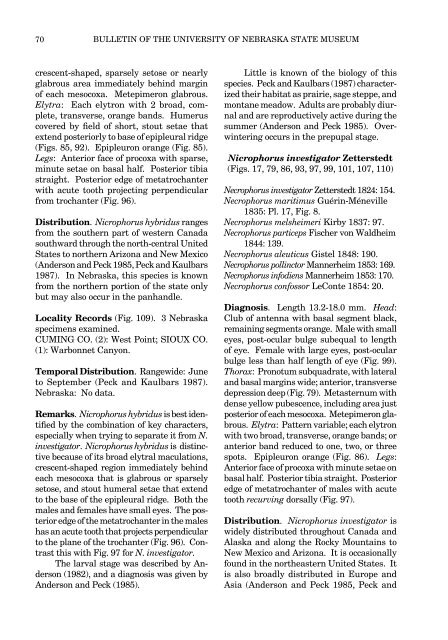Download full text - University of Nebraska State Museum
Download full text - University of Nebraska State Museum
Download full text - University of Nebraska State Museum
Create successful ePaper yourself
Turn your PDF publications into a flip-book with our unique Google optimized e-Paper software.
70<br />
BULLETIN OF THE UNIVERSITY OF NEBRASKA STATE MUSEUM<br />
crescent-shaped, sparsely setose or nearly<br />
glabrous area immediately behind margin<br />
<strong>of</strong> each mesocoxa. Metepimeron glabrous.<br />
Elytra: Each elytron with 2 broad, complete,<br />
transverse, orange bands. Humerus<br />
covered by field <strong>of</strong> short, stout setae that<br />
extend posteriorly to base <strong>of</strong> epipleural ridge<br />
(Figs. 85, 92). Epipleuron orange (Fig. 85).<br />
Legs: Anterior face <strong>of</strong> procoxa with sparse,<br />
minute setae on basal half. Posterior tibia<br />
straight. Posterior edge <strong>of</strong> metatrochanter<br />
with acute tooth projecting perpendicular<br />
from trochanter (Fig. 96).<br />
Distribution. Nicrophorus hybridus ranges<br />
from the southern part <strong>of</strong> western Canada<br />
southward through the north-central United<br />
<strong>State</strong>s to northern Arizona and New Mexico<br />
(Anderson and Peck 1985, Peck and Kaulbars<br />
1987). In <strong>Nebraska</strong>, this species is known<br />
from the northern portion <strong>of</strong> the state only<br />
but may also occur in the panhandle.<br />
Locality Records (Fig. 109). 3 <strong>Nebraska</strong><br />
specimens examined.<br />
CUMING CO. (2): West Point; SIOUX CO.<br />
(1): Warbonnet Canyon.<br />
Temporal Distribution. Rangewide: June<br />
to September (Peck and Kaulbars 1987).<br />
<strong>Nebraska</strong>: No data.<br />
Remarks. Nicrophorus hybridus is best identified<br />
by the combination <strong>of</strong> key characters,<br />
especially when trying to separate it from N.<br />
investigator. Nicrophorus hybridus is distinctive<br />
because <strong>of</strong> its broad elytral maculations,<br />
crescent-shaped region immediately behind<br />
each mesocoxa that is glabrous or sparsely<br />
setose, and stout humeral setae that extend<br />
to the base <strong>of</strong> the epipleural ridge. Both the<br />
males and females have small eyes. The posterior<br />
edge <strong>of</strong> the metatrochanter in the males<br />
has an acute tooth that projects perpendicular<br />
to the plane <strong>of</strong> the trochanter (Fig. 96). Contrast<br />
this with Fig. 97 for N. investigator.<br />
The larval stage was described by Anderson<br />
(1982), and a diagnosis was given by<br />
Anderson and Peck (1985).<br />
Little is known <strong>of</strong> the biology <strong>of</strong> this<br />
species. Peck and Kaulbars (1987) characterized<br />
their habitat as prairie, sage steppe, and<br />
montane meadow. Adults are probably diurnal<br />
and are reproductively active during the<br />
summer (Anderson and Peck 1985). Overwintering<br />
occurs in the prepupal stage.<br />
Nicrophorus investigator Zetterstedt<br />
(Figs. 17, 79, 86, 93, 97, 99, 101, 107, 110)<br />
Necrophorus investigator Zetterstedt 1824: 154.<br />
Necrophorus maritimus Guérin-Méneville<br />
1835: Pl. 17, Fig. 8.<br />
Necrophorus melsheimeri Kirby 1837: 97.<br />
Necrophorus particeps Fischer von Waldheim<br />
1844: 139.<br />
Necrophorus aleuticus Gistel 1848: 190.<br />
Necrophorus pollinctor Mannerheim 1853: 169.<br />
Necrophorus infodiens Mannerheim 1853: 170.<br />
Necrophorus confossor LeConte 1854: 20.<br />
Diagnosis. Length 13.2-18.0 mm. Head:<br />
Club <strong>of</strong> antenna with basal segment black,<br />
remaining segments orange. Male with small<br />
eyes, post-ocular bulge subequal to length<br />
<strong>of</strong> eye. Female with large eyes, post-ocular<br />
bulge less than half length <strong>of</strong> eye (Fig. 99).<br />
Thorax: Pronotum subquadrate, with lateral<br />
and basal margins wide; anterior, transverse<br />
depression deep (Fig. 79). Metasternum with<br />
dense yellow pubescence, including area just<br />
posterior <strong>of</strong> each mesocoxa. Metepimeron glabrous.<br />
Elytra: Pattern variable; each elytron<br />
with two broad, transverse, orange bands; or<br />
anterior band reduced to one, two, or three<br />
spots. Epipleuron orange (Fig. 86). Legs:<br />
Anterior face <strong>of</strong> procoxa with minute setae on<br />
basal half. Posterior tibia straight. Posterior<br />
edge <strong>of</strong> metatrochanter <strong>of</strong> males with acute<br />
tooth recurving dorsally (Fig. 97).<br />
Distribution. Nicrophorus investigator is<br />
widely distributed throughout Canada and<br />
Alaska and along the Rocky Mountains to<br />
New Mexico and Arizona. It is occasionally<br />
found in the northeastern United <strong>State</strong>s. It<br />
is also broadly distributed in Europe and<br />
Asia (Anderson and Peck 1985, Peck and
















